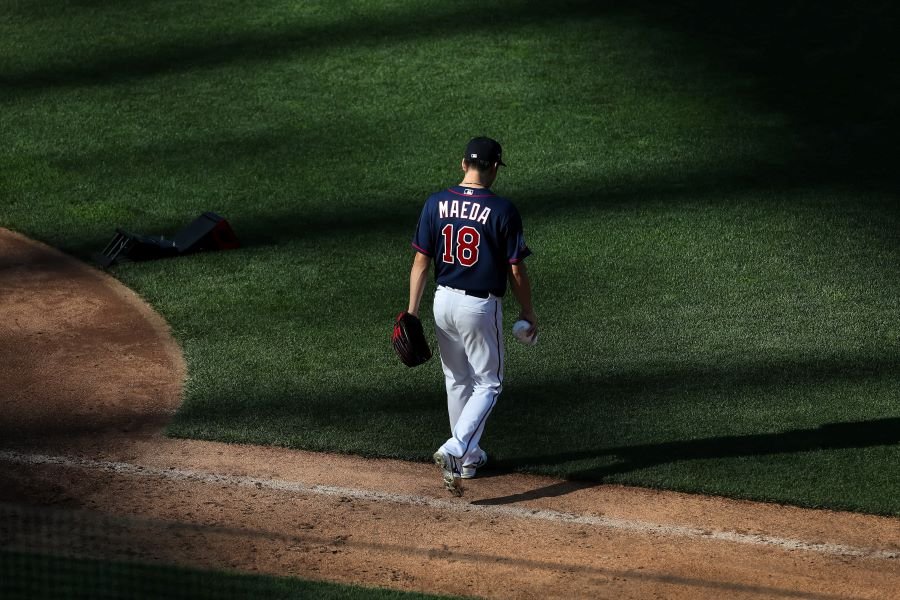
Twins Video
Minnesota had many reasons to be interested in trading for Kenta Maeda before the 2020 season. He had shown positive signs during his time in Los Angeles, and the Dodgers had an influx of starting pitching. He pitched over 125 innings in each of his first four big-league seasons, but the team tended to move him to a bullpen role as the season came to a close.
Injury concerns might have been one of the reasons the Dodgers tried to limit Maeda’s innings. (At least that sounds better than trying to limit how much they had to pay him.) When he initially signed from Japan, his physical exam revealed “irregularities” in his right elbow. At the time, MLB.com said, “the strong suspicion is that he will need Tommy John reconstruction at some point.”
This prognosis resulted in a very team-friendly eight-year contract which guaranteed Maeda a minimum of $25 million with a chance to be worth over $106 million. This gave the Dodgers some wiggle room if Maeda did go under the knife. He pitched over 600 innings for the Dodgers, and they went on multiple World Series runs, and his elbow wasn’t an issue.
Team-controlled starting pitching is one of baseball’s most valuable assets, so Maeda was an easy target for the Twins. His team-friendly deal was a positive, and he hadn’t shown any injury concerns up to this point. Any team trading for a player gets access to their medical records, so there must not have been anything out of the ordinary regarding Maeda’s physical. Plus, the Twins saw their winning window was open, and Maeda helped make the team better.
Maeda provided Minnesota with everything they wanted and more during his first season with the club. He finished runner-up for the Cy Young Award after a dominating season where he posted a 2.70 ERA and an MLB-leading 0.75 WHIP. He struck out 80 batters in 66 2/3 innings while only issuing ten walks.
From the other perspective, Brusdar Graterol has pitched less than 50 innings for the Dodgers. He has posted a 3.50 ERA with 33 strikeouts in 46 1/3 innings. Graterol makes hitting triple-digits look easy, but he has yet to develop into a dominant late-inning reliever. He won’t be arbitration-eligible until 2023, and he can’t reach free agency until 2026, so there is plenty of time for the 22-year-old to develop.
Two minor league players and a draft pick were also part of this trade. Luke Raley went back to LA after initially being part of the Brian Dozier trade. He has 30 big-league games under his belt, and he has hit .169/.246/.237 with two extra-base hits. He has mashed with a .982 OPS at Triple-A this season, and 29 extra-base hits in 58 games. The Dodger also received a 2020 competitive balance round pick (66th overall), which they used to select Clayton Beeter. He has been used in an opener style role this season while posting a 2.89 ERA and a 1.12 WHIP with 13.8 K/9. Minnesota received Jair Camargo, who has hit .233/.281/.452 with 21 extra-base hits at High-A Cedar Rapids this year.
Maeda’s recent injury news means there is a good chance he misses all of the 2022 season, and that might be the season Minnesota needs him the most. Also, a missed season means the next time he steps on the mound will be during his age-35 campaign.
So what do you think? Which team do you think won the trade, or is it still too early to judge?
Leave a COMMENT and start the discussion.
MORE FROM TWINS DAILY
— Latest Twins coverage from our writers
— Recent Twins discussion in our forums
— Follow Twins Daily via Twitter, Facebook or email
MORE FROM TWINS DAILY
— Latest Twins coverage from our writers
— Recent Twins discussion in our forums
— Follow Twins Daily via Twitter, Facebook or email
— Become a Twins Daily Caretaker
- glunn and mikelink45
-
 2
2







Recommended Comments
Join the conversation
You can post now and register later. If you have an account, sign in now to post with your account.
Note: Your post will require moderator approval before it will be visible.